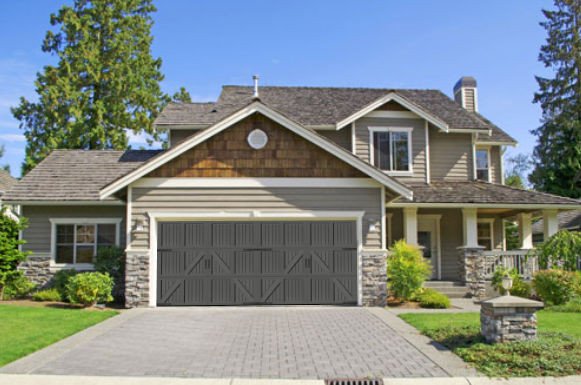Gray House With Black Garage Door

The seemingly innocuous image of a gray house with a black garage door has become a flashpoint in a growing debate over suburban aesthetics, property values, and the power of homeowners' associations (HOAs). What started as simple curb appeal preference has escalated into legal battles, heated community meetings, and accusations of architectural tyranny, forcing many to question the very definition of neighborhood harmony.
This article delves into the complexities surrounding this unexpected controversy, exploring the arguments for and against restrictive design standards, the legal precedents that are shaping the debate, and the potential long-term consequences for communities across the nation. At the heart of the matter lies a fundamental tension: the individual homeowner's right to personalize their property versus the community's desire to maintain a cohesive and potentially value-enhancing aesthetic.
The Rise of Architectural Restrictions
The proliferation of HOAs in recent decades has given rise to a new era of architectural control. These organizations, designed to maintain property values and community standards, often wield significant power over homeowners' decisions, ranging from lawn maintenance to exterior paint colors. Critics argue this power can stifle creativity and individuality, leading to homogenized landscapes that lack character.
The gray house, black garage door trend has inadvertently become a symbol of this conflict, representing a modern aesthetic often at odds with more traditional preferences prevalent in established communities. Many HOAs have regulations specifying acceptable color palettes for exterior features, including garage doors, often favoring muted or earth-toned hues.
Data from the Community Associations Institute (CAI) indicates that over 73.5 million Americans now live in communities governed by HOAs, highlighting the widespread impact of these organizations on homeowners' lives. This rise in HOA membership has been accompanied by a surge in disputes over architectural guidelines, with color choices frequently cited as a major source of contention.
Legal Battles and HOA Authority
Several high-profile cases involving disputes over exterior color choices have made their way through the courts, setting legal precedents that are shaping the boundaries of HOA authority. In some instances, courts have sided with homeowners, arguing that HOA restrictions are unreasonable or arbitrarily enforced. Conversely, other rulings have upheld the HOA's right to maintain community standards, even if those standards limit individual expression.
One notable case, Smith v. Oakwood HOA, involved a homeowner who was fined repeatedly for painting their garage door a shade of gray deemed unacceptable by the HOA's architectural committee. The homeowner argued that the gray was similar to other approved colors in the community, and that the HOA's decision was arbitrary and capricious.
The court ultimately ruled in favor of the HOA, finding that the restrictions were clearly outlined in the governing documents and that the HOA had a legitimate interest in maintaining a consistent aesthetic. This ruling reinforced the principle that homeowners are bound by the rules and regulations of their HOA, even if they disagree with them.
Perspectives from the Community
Homeowners' Views
Opinions on the gray house, black garage door trend, and HOA restrictions in general, are deeply divided. Some homeowners embrace the modern aesthetic and argue that they should have the freedom to personalize their property as they see fit, as long as it doesn't violate any safety or zoning regulations.
"I think it's ridiculous that an HOA can dictate what color I paint my garage door," says Sarah Miller, a homeowner in a suburban community with strict architectural guidelines. "It's my property, and I should be able to express my own style. As long as my house is well-maintained, I don't see why anyone should care what color my garage door is."
Others believe that HOAs play a crucial role in maintaining property values and community standards. They argue that restrictive guidelines are necessary to prevent homeowners from making choices that could negatively impact the overall aesthetic of the neighborhood.
HOA Representatives' Stance
HOA representatives often defend their design standards as a means of protecting the collective interests of the community. They argue that consistent architectural guidelines help to maintain property values and create a sense of cohesion.
"Our design standards are in place to ensure that our community maintains its aesthetic appeal and property values," explains John Davis, president of the Greenwood Estates HOA. "We understand that some homeowners may not agree with all of our rules, but we believe that they are ultimately in the best interests of the community as a whole."
The Future of Suburban Aesthetics
The debate over the gray house, black garage door trend is likely to continue as suburban communities grapple with changing aesthetic preferences and the increasing influence of HOAs. Finding a balance between individual expression and community standards will be crucial to fostering harmonious neighborhoods.
Moving forward, HOAs may need to consider revising their design standards to reflect evolving tastes and incorporate more flexibility. Open communication and collaboration between homeowners and HOA boards will be essential to resolving disputes and creating communities that are both aesthetically pleasing and inclusive.
Ultimately, the gray house, black garage door controversy serves as a reminder that even seemingly minor aesthetic choices can have significant implications for property values, community harmony, and the individual homeowner's right to self-expression. The resolution of this debate will shape the future of suburban landscapes for years to come.


















